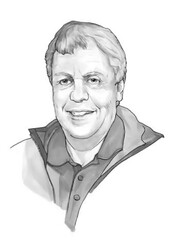Leading by example with bioheat and hydropower
Sustainabilty in the region
St. Anton am Arlberg is one of the few Tyrolean communities that can boast of being almost completely self-sufficient in terms of energy supply, thanks to environmentally friendly methods of electricity production.
The community may have just under 3000 residents, but with 20,000 sport-loving guests visiting per day at times, it has the electricity requirements of a medium-sized town: St. Anton am Arlberg was quick to rise to the challenge, relying on the use of clean hydropower as early as the beginning of the 20th century and thus laying the foundation for an environmentally friendly network with guaranteed supply. This development was promoted by the energy and economic enterprises of the municipality of St. Anton (EWA extern). Its managing director, Markus Strolz, explains in an interview how many millions of litres of heating oil and how many tonnes of CO2 can be saved annually thanks to the district heating facility. He also talks about the challenges of the future and appeals to all consumers.

Interview with Markus Strolz, EWA Management

To what extent is St. Anton am Arlberg energy self-sufficient, and what advantages does that bring to the village?
EWA supply St. Anton and the district of St. Jakob. TIWAG (Tiroler Wasserkraft AG) supplies the St. Christoph district and the Arlberg cable cars. We generate around 53 gigawatt hours a year, of which around 33 GWh are consumed in the region. In winter we also purchase additional energy, because of the decreased water supply. The fact that our power plants can operate on an isolated basis, means we can continue to supply our customers even if our partner TIWAG fails. Another advantage is the extremely favourable electricity price.
How is the new district heating plant performing in practice?
“Nahwärme St. Anton GmbH” (NWSA) district heating plant is another step towards the sustainability of our village. At present, it supplies around 80 properties, saving circa 1.8 million litres of heating oil and around 4,800 tonnes of CO2 annually in the process. Network densification is ongoing, and further expansion into other parts of the village is planned.
The former power plant and EWA have operated a forward-thinking energy management system. What are the social implications of EWA for the village?
The Energy and Business Enterprises of the municipality of St. Anton am Arlberg (EWA) are an important source of employment. They currently employ 70 yearround employees from St. Anton and the surrounding area, who work in different facilities: generation (power plants), grid (high voltage, low voltage, transformer stations), municipal areas (water supply, waste water disposal, recycling centre, waste disposal, disposal sites for excavated material), building yard (winter services with snow removal, townscape maintenance, building maintenance, road maintenance) and commercial operations (installation company, kitchens, trade and customer service).
What are the challenges for the future?
Our goal must be to secure the energy supply in a sustainable manner, to further expand it and offer it at favourable prices. We are currently installing photovoltaic systems for the municipality of St. Anton am Arlberg; in addition, the technical facilities must be continuously updated and adapted to meet requirements. We also appeal to consumers: to ensure the efficient and economical use of energy, which is a valuable contribution to climate protection and helps conserve resources.
The power that creates prosperity
A success story starting with the first small power plant to comprehensive energy management.

1907
Full power into the future was the motto in St. Anton as early as 1907, when the lights were switched on in the up-and-coming town on the Arlberg. Using the power of the Rosanna River, a 20-kW hydroelectric power plant supplied several guesthouses with energy for electric lighting.

1921
In 1921, St. Anton municipality's electricity plant was founded with the construction of Moosbach power station. In 1940, the supply from Gand to St. Christoph encompassed 274 houses. Too few for the growing community, where many accommodation establishments and the mountain cableways also required electricity. For this reason, TIWAG (Tiroler Wasserkraft AG) joined as a partner in 1953.

1985
In 1985, the new power station on the Rosanna River with the Verwall Reservoir (31 m high dam wall, working volume of approx. 225,000 m³) was completed. The reservoir became a popular destination for excursions and the municipality's annual demand was largely covered (only a small amount of additional electricity was purchased in winter).

1999
In 1999, St. Anton’s power plant was renamed "EWA Energie- und Wirtschaftsbetriebe der Gemeinde St. Anton GmbH” (which translates to: Energy and Business Enterprises of the municipality of St. Anton am Arlberg Ltd.), who are also responsible for water supply, sewage, waste disposal and the building yard.

2005
In 2005, the Kartell power plant (8 million m³ of water at 2000m above sea level) went into operation. In 2014, "Arlberg Strom" (Arlberg Electricity) was established as a brand and, from October of the same year, Stanzertal hydroelectric power plant, in which EWA and the municipality of St. Anton am Arlberg have a stake, has supplied around 14,000 households with around 52 million kilowatt hours of green electricity.

2021
In 2021, the local heating plant in St. Anton am Arlberg was opened, which is wholly owned by EWA Ltd. EWA's power plants currently produce a total output of around 12 megawatts.